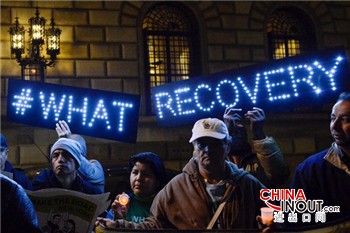華盛頓——本周三,,美聯(lián)儲(Federal Reserve)表示將自金融危機爆發(fā)以來首次提高短期利率。就在全球其他很多地區(qū)的經濟發(fā)展步履維艱之際,,此舉給美國經濟的強勁投下了信任票,。
這個決定符合外界的廣泛預期,是美聯(lián)儲在金融危機后采取的經濟刺激行動的一個里程碑,,結束了它七年來將短期利率維持在接近于零的狀態(tài),。然而,即使基準利率本次上調了0.25個百分點,,到達0.25%至0.5%的區(qū)間,,美聯(lián)儲也強調,后續(xù)的加息步伐將會相當緩慢,。
加息決定宣布之后,,美聯(lián)儲主席珍妮特·L·耶倫(Janet L.Yellen)在新聞發(fā)布會上表示,這個決定“承認了在恢復就業(yè),、增加收入,、緩解困擾無數美國普通民眾的經濟困難方面,美國取得了相當大的進展,。”
未來數年,,抵押貸款等各種類型的貸款及儲蓄賬戶等各種類型的投資的利率,很可能仍將維持在歷史低位,。
耶倫在2014年初成為美聯(lián)儲主席,,開始加息是該機構在她領導期間做出的最重要的、風險最大的決定,。
自金融危機結束以來,,所有加過息的其他發(fā)達國家全都被迫走上了回頭路,因為事實證明,,它們的經濟狀況無法承受更高的利率。隨著投資者拋售高收益垃圾債券,,并從發(fā)展中國家的市場里抽走資金,,某些金融市場已經出現(xiàn)了承壓跡象,。
加息決定獲得了聯(lián)邦公開市場委員會(Federal Open Market Committee)中10個擁有投票權的成員的一致支持。雖然其中三名成員在近幾個月里表示了擔憂,,認為美國經濟可能還沒有為更高的利率做好準備,,他們仍然贊成了此次加息舉動。一些外部經濟學家同意這種擔憂,,一些民主黨人也認為美聯(lián)儲此舉將過早地削弱就業(yè)和工資增長,。
在聲明中,美聯(lián)儲把就業(yè)增長的力度以及緩慢但穩(wěn)定的經濟增長的大背景列為證據,,證明美國經濟不再需要超低借貸成本提供那么多的幫助,。
美聯(lián)儲官員本周三還發(fā)布了一系列預測,表示他們預計在未來三年內將以每年一個百分點的速度提高利率,,至2019年時達到3.3%,。

WASHINGTON — The Federal Reserve said on Wednesday that it would raise short-term interest rates for the first time since the financial crisis struck, a vote of confidence in the strength of the American economy at a time when much of the rest of the global economy is struggling.
The widely anticipated decision, a milestone in the Fed’s postcrisis stimulus campaign, ends a seven-year period in which the Fed held short-term rates near zero. Even as it raises its benchmark interest rate by 0.25 percentage points, to a range of 0.25 to 0.5 percent, however, the Fed emphasized subsequent increases would come slowly.
The decision to raise rates “recognizes the considerable progress that has been made toward restoring jobs, raising incomes and easing the economic hardships that have been endured by millions of ordinary Americans,” the Fed’s chairwoman, Janet L. Yellen, said at a news conference after the decision was announced.
Interest rates on mortgages and other kinds of loans, and on savings accounts and other kinds of investments, are likely to remain low by historical standards for years to come.
Moving to raise rates is the most important and riskiest decision the Fed has made under the leadership of Ms. Yellen, the Fed’s chairwoman since early 2014.
Every other developed nation that has raised rates since the end of the financial crisis has been forced to backtrack as economic conditions proved unable to handle higher rates. There are also signs of strain in some financial markets as investors dump high-yield junk bonds and pull money from developing markets.
The decision to raise rates was supported by all 10 voting members of the Federal Open Market Committee. They agreed on the move despite concern expressed in recent months by three of those officials that the economy might not be ready for higher rates, a view shared by some outside economists and by Democrats who argue the Fed is prematurely curtailing job and wage growth.
The Fed’s announcement cited the strength of job growth, and the broader backdrop of a moderate-but-steady economic expansion, as evidence that the economy no longer needed quite as much help from ultralow borrowing costs.
Fed officials predicted in a set of forecasts also published Wednesday that they would raise interest rates by about one percentage point a year over the next three years, reaching 3.3 percent by 2019.











